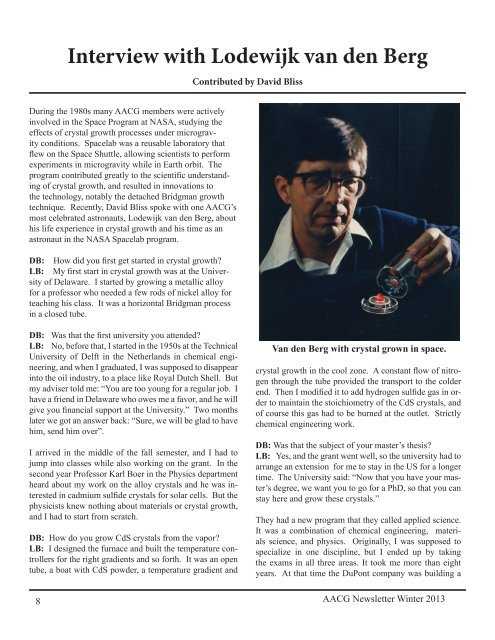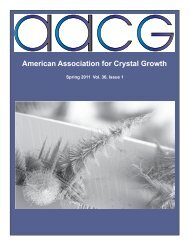President's Corner (cont.) - American Association for Crystal Growth
President's Corner (cont.) - American Association for Crystal Growth
President's Corner (cont.) - American Association for Crystal Growth
You also want an ePaper? Increase the reach of your titles
YUMPU automatically turns print PDFs into web optimized ePapers that Google loves.
8<br />
Interview with Lodewijk van den Berg<br />
During the 1980s many AACG members were actively<br />
involved in the Space Program at NASA, studying the<br />
effects of crystal growth processes under microgravity<br />
conditions. Spacelab was a reusable laboratory that<br />
flew on the Space Shuttle, allowing scientists to per<strong>for</strong>m<br />
experiments in microgravity while in Earth orbit. The<br />
program <strong>cont</strong>ributed greatly to the scientific understanding<br />
of crystal growth, and resulted in innovations to<br />
the technology, notably the detached Bridgman growth<br />
technique. Recently, David Bliss spoke with one AACG’s<br />
most celebrated astronauts, Lodewijk van den Berg, about<br />
his life experience in crystal growth and his time as an<br />
astronaut in the NASA Spacelab program.<br />
DB: How did you first get started in crystal growth?<br />
LB: My first start in crystal growth was at the University<br />
of Delaware. I started by growing a metallic alloy<br />
<strong>for</strong> a professor who needed a few rods of nickel alloy <strong>for</strong><br />
teaching his class. It was a horizontal Bridgman process<br />
in a closed tube.<br />
DB: Was that the first university you attended?<br />
LB: No, be<strong>for</strong>e that, I started in the 1950s at the Technical<br />
University of Delft in the Netherlands in chemical engineering,<br />
and when I graduated, I was supposed to disappear<br />
into the oil industry, to a place like Royal Dutch Shell. But<br />
my adviser told me: “You are too young <strong>for</strong> a regular job. I<br />
have a friend in Delaware who owes me a favor, and he will<br />
give you financial support at the University.” Two months<br />
later we got an answer back: “Sure, we will be glad to have<br />
him, send him over”.<br />
I arrived in the middle of the fall semester, and I had to<br />
jump into classes while also working on the grant. In the<br />
second year Professor Karl Boer in the Physics department<br />
heard about my work on the alloy crystals and he was interested<br />
in cadmium sulfide crystals <strong>for</strong> solar cells. But the<br />
physicists knew nothing about materials or crystal growth,<br />
and I had to start from scratch.<br />
DB: How do you grow CdS crystals from the vapor?<br />
LB: I designed the furnace and built the temperature <strong>cont</strong>rollers<br />
<strong>for</strong> the right gradients and so <strong>for</strong>th. It was an open<br />
tube, a boat with CdS powder, a temperature gradient and<br />
Contributed by David Bliss<br />
Van den Berg with crystal grown in space.<br />
crystal growth in the cool zone. A constant flow of nitrogen<br />
through the tube provided the transport to the colder<br />
end. Then I modified it to add hydrogen sulfide gas in order<br />
to maintain the stoichiometry of the CdS crystals, and<br />
of course this gas had to be burned at the outlet. Strictly<br />
chemical engineering work.<br />
DB: Was that the subject of your master’s thesis?<br />
LB: Yes, and the grant went well, so the university had to<br />
arrange an extension <strong>for</strong> me to stay in the US <strong>for</strong> a longer<br />
time. The University said: “Now that you have your master’s<br />
degree, we want you to go <strong>for</strong> a PhD, so that you can<br />
stay here and grow these crystals.”<br />
They had a new program that they called applied science.<br />
It was a combination of chemical engineering, materials<br />
science, and physics. Originally, I was supposed to<br />
specialize in one discipline, but I ended up by taking<br />
the exams in all three areas. It took me more than eight<br />
years. At that time the DuPont company was building a<br />
AACG Newsletter Winter 2013




